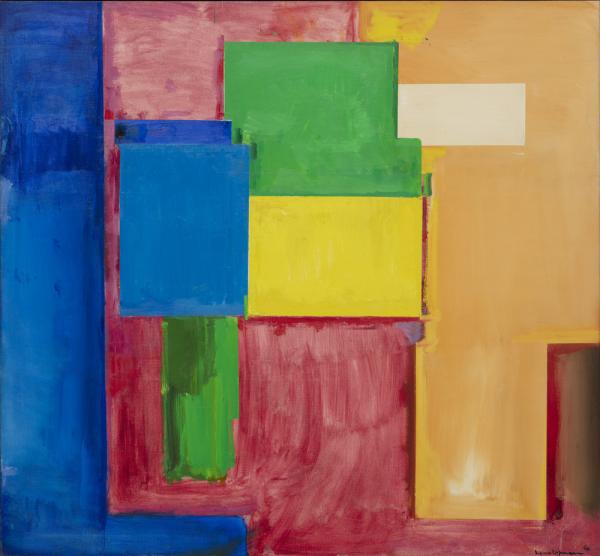Skip to main content
To Miz-Pax Vobiscum
Artist
Hans Hofmann
(American, born Germany, 1880 - 1966)
Date1964
MediumOil on canvas
DimensionsUnframed: 77 3/8 x 83 5/8 in. (196.53 x 212.41 cm)
Framed: 78 3/4 x 85 1/8 x 1 3/4 in. (200.03 x 216.22 x 4.45 cm)
Framed: 78 3/4 x 85 1/8 x 1 3/4 in. (200.03 x 216.22 x 4.45 cm)
Credit LineCollection of the Modern Art Museum of Fort Worth, Museum purchase
Object number1987.3
Status
Not on viewSignedrecto l.r.c. "Hans Hofmann 64"
Copyright© 2020 Estate of Hans Hofmann / Artists Rights Society (ARS), New York
Category
Label TextHans Hofmann painted To Miz—Pax Vobiscum, 1964, near the end of his long career as an eminent painter and influential teacher. Stylistically, the painting, with its striking rectangular planes of color, exemplifies his late style, while chronologically and personally, the composition suggests an occasion of closure and renewal for the artist.
Born in Bavaria, Hofmann studied art in Munich before moving to Paris. There, he absorbed the lessons of Fauvism and Cubism that were to continually inform his art. To Miz—Pax Vobiscum, for example, combines Fauvism’s expressive coloration with the mass–space simultaneity of Cubism. Hofmann returned to Germany with the outbreak of World War I in 1914 and remained there until 1930, when he emigrated to the United States. In 1933, he opened an influential art school and taught classes for the next twenty-five years.
Hoffman coined the phrase “push and pull” to signify a composition’s ability to evoke flatness and depth simultaneously through a counterplay of formal elements. “Push and pull” is evident in the Modern’s painting, where abutting and overlapping planes, juxtaposed colors, and varied brushwork produce a dynamic tension between surface and space.
Maria Wolfegg Hofmann, known as Miz, died in 1963. She had met the artist in 1900 and married him in 1924. To Miz—Pax Vobiscum was created during the artist’s period of mourning. Hofmann explained the work as expressing his “negative ecstasy”—a phrase that suggests the artist’s acceptance of the mystery of life and death. That the painting offered him emotional resolution is suggested by the Latin phrase in the painting’s dedicatory title: “Pax vobiscum” means “peace be with you.”
Born in Bavaria, Hofmann studied art in Munich before moving to Paris. There, he absorbed the lessons of Fauvism and Cubism that were to continually inform his art. To Miz—Pax Vobiscum, for example, combines Fauvism’s expressive coloration with the mass–space simultaneity of Cubism. Hofmann returned to Germany with the outbreak of World War I in 1914 and remained there until 1930, when he emigrated to the United States. In 1933, he opened an influential art school and taught classes for the next twenty-five years.
Hoffman coined the phrase “push and pull” to signify a composition’s ability to evoke flatness and depth simultaneously through a counterplay of formal elements. “Push and pull” is evident in the Modern’s painting, where abutting and overlapping planes, juxtaposed colors, and varied brushwork produce a dynamic tension between surface and space.
Maria Wolfegg Hofmann, known as Miz, died in 1963. She had met the artist in 1900 and married him in 1924. To Miz—Pax Vobiscum was created during the artist’s period of mourning. Hofmann explained the work as expressing his “negative ecstasy”—a phrase that suggests the artist’s acceptance of the mystery of life and death. That the painting offered him emotional resolution is suggested by the Latin phrase in the painting’s dedicatory title: “Pax vobiscum” means “peace be with you.”









